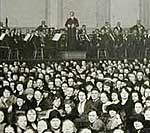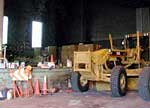Using the past to shape the future
By Stephanie Hemphill
Minnesota Public Radio
December 10, 2001
|
| RealAudio |
For decades, Minnesotans have known Duluth as the gateway to the North Shore and the northwoods. But most people usually drove straight through what looked and felt like a gritty rustbelt city. Duluth's declining industrial base meant a declining population, and at the nadir of Duluth's fortunes, someone put up a billboard that said, "Will the last one to leave Duluth please turn out the lights?"
In recent years, the city has been turning itself around. After a long battle over how and where to extend Interstate 35 through downtown, Duluth used some of the freeway money to pave downtown streets with bricks, and build a Lakewalk along the shore. Now the Canal Park area is a popular destination, and people love to stay in Duluth.
| |
|
|
|
||
Duluthians feel a new pride in their town. They're noticing what makes the place special. The most obvious things - besides the active port - are the city's green spaces and historic buildings. Some people say Duluth can use those old buildings to create a new future.
But others say the preservationist movement is hobbling the city's efforts to bring new jobs to town. The city's old armory is the current battlefield in that ongoing conflict.
The old Duluth armory - four stories of classic dignity - was built in 1915 of local brick that has an unusual greenish color.
Carolyn Sundquist says it's sitting on an ideal spot, at the eastern edge of downtown Duluth. Across the street is the Rose Garden, and beyond that, a panoramic view of Lake Superior. Sundquist says the public park protects the view from this spot. Nothing will ever be built between the armory and Lake Superior.
"You can see the little gazebo and the historic horse watering trough in their perfect settings in the Rose Garden, and the Lakewalk is down below," Sundquist says.
This armory cost four times as much as most armories of its time. It had club rooms, meeting rooms, and a ballroom on the top floor.
Now, paint is peeling from the ballroom's walls, and the hardwood floor curls up in places. But Carolyn Sundquist can picture people dancing here again, and concerts, and plays. She's working with other volunteers to save the armory from being torn down.
Standing in the ballroom with her friend Susan Phillips, she recalls an old poster Phillips found, advertising an early concert series.
"It was called 'Mrs. Richardson's series of cultural events,' and the year was 1918, and who was coming that year, Paderewski?"
| |
|
|
|
||
Phillips finishes the thought. "Yes, Paderewski, and other top performers from Chicago. It was called the New Armory, and it was proof it started as an arts and music center," says Phillips.
The armory was built in Duluth's heyday, when there was plenty of money. Now the building is a bit run down, like the city's economy. But for Sundquist and Phillips, the potential is still here.
In another part of the armory, the drill room is nearly the size of a football field. This is where soldiers marched, and even practiced digging foxholes, with sand brought in for the purpose.
In the 1960s and '70s, a new armory and a new entertainment center went up. And the city turned the old armory into a garage.
Carolyn Sundquist grew up in Duluth. She says for years, the armory was the soul of the community.
"Everything that went on in Duluth went on here, from sheltering the 1918 victims of the Cloquet fire, to basketball tournaments, to symphony concerts, to Buddy Holly - and everything else in between."
The Buddy Holly concert was in 1959. In the audience was a young, impressionable musician, who later called himself Bob Dylan. Years later, Dylan would say that concert inspired his career.
Susan Phillips is a marketing consultant, who recently moved to Duluth from New York City. She says the Dylan connection is a treasure that can help create a future for the building.
"Bob Dylan never talks about anything, and in 1998 he gets up at the Grammy Awards on international television and talks about seeing Buddy Holly play when he was 16 or 17 years old."
Phillips says Dylan is famous for protecting his private life, and the personal comment on international television was highly unusual. "So this building has that story. And they always say stories drive projects, and this story is driving this project."
|
"Everything that went on in Duluth went on here, from sheltering the 1918 victims of the Cloquet fire, to basketball tournaments, to symphony concerts, to Buddy Holly - and everything else in between."
- Carolyn Sundquist |
Phillips and Sundquist want to return the armory to its former use as a community and arts center. Their group envisions an antique mart and farmer's market in the old auditorium space. A local entrepreneur might open a restaurant, and there's plenty of space for specialty shops, offices, and studios.
A few other cities have rehabbed their armories in similar ways. Jim Guelcher, with the National Trust for Historic Preservation in Chicago, says it's a great way to bring tourists to town. He says Duluth has lots of buildings worth preserving and re-using. That's the silver lining in Duluth's economic gloom.
"For decades it's been relatively static," Guelcher says. "And when you don't have new money coming into economies, no one tends to knock things down as much, if that makes sense. So you keep more of the building stock."
But Guelcher says until recently, people in Duluth haven't recognized the value in those old buildings.
A few individuals and non-profit groups have preserved some public buildings. Bed-and-breakfasts in restored mansions are successful. But they haven't had much help from the city government.
A couple of years ago, the city tore down three buildings in the heart of the historic downtown district. They needed the space for the new Technology Village, a development project that so far has failed to meet expectations. One person was so upset at the demolitions, he sued the city. He lost, but the delay and public outcry forced the city to design the new building to fit in better with the older buildings around it.
Duluth has had a lot of battles over development versus preservation.
Jim Guelcher says that's holding the city back. He wants to get city officials and preservation activists to listen to each other. His goal is to get them to work together.
| |
|
|
|
||
"We would really like to shift that paradigm, from preservation folks being seen as reacting in opposition to city policy," Guelcher says. His group is coaching activists, helping them build connections to the city power structure. "They should be influencing decisions before it's a 'stop-the-bulldozer, stop-the-wrecking ball' mentality."
Duluth's mayor, Gary Doty, is a veteran of these battles. During his three terms as mayor, he's been in the thick of fights over many major projects. Doty invented a name for people he says are against development of any kind. He once called them "CAVE" people - "citizens against virtually everything."
"Some of the people who I think are obstructionists in the commmunity need to realize that development does have to take place," Doty says. He says there has to be a balance between historic preservation and the environment on the one hand, and business development on the other hand. Doty says, "I'm willing to compromise, but there are some people that aren't."
Preservation advocates say working together can get better than merely compromising. They say preservation and economic development can go hand in hand.
They say the old armory can be preserved as a special part of Duluth's history. And at the same time it can be a tool for development. It can be home for a mix of arts activities and technology businesses that could help revitalize Duluth's downtown.
In addition to all that, it just might be the project that brings Duluth's feuding groups together. Mayor Doty says as long as there's a chance the old armory can find new life, he won't knock it down.
More Information


